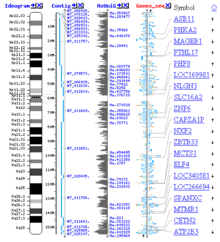Computational biology
Computational biology refers to the use of data analysis, mathematical modeling and computational simulations to understand biological systems and relationships.[1] An intersection of computer science, biology, and big data, the field also has foundations in applied mathematics, chemistry, and genetics.[2] It differs from biological computing, a subfield of computer engineering which uses bioengineering to build computers.
Bioinformatics, the analysis of informatics processes in biological systems, began in the early 1970s. At this time, research in artificial intelligence was using network models of the human brain in order to generate new algorithms. This use of biological data pushed biological researchers to use computers to evaluate and compare large data sets in their own field.[3]
By 1982, researchers shared information via punch cards. The amount of data grew exponentially by the end of the 1980s, requiring new computational methods for quickly interpreting relevant information.[3]
Perhaps the best-known example of computational biology, the Human Genome Project, officially began in 1990.[4] By 2003, the project had mapped around 85% of the human genome, satisfying its initial goals.[5] Work continued, however, and by 2021 level "complete genome" was reached with only 0.3% remaining bases covered by potential issues.[6][7] The missing Y chromosome was added in January 2022.
Since the late 1990s, computational biology has become an important part of biology, leading to numerous subfields.[8] Today, the International Society for Computational Biology recognizes 21 different 'Communities of Special Interest', each representing a slice of the larger field.[9] In addition to helping sequence the human genome, computational biology has helped create accurate models of the human brain, map the 3D structure of genomes, and model biological systems.[3]
Computational anatomy is the study of anatomical shape and form at the visible or gross anatomical scale of morphology. It involves the development of computational mathematical and data-analytical methods for modeling and simulating biological structures. It focuses on the anatomical structures being imaged, rather than the medical imaging devices. Due to the availability of dense 3D measurements via technologies such as magnetic resonance imaging, computational anatomy has emerged as a subfield of medical imaging and bioengineering for extracting anatomical coordinate systems at the morpheme scale in 3D.
.jpg/440px-Human_Genome_Project_Timeline_(26964377742).jpg)

